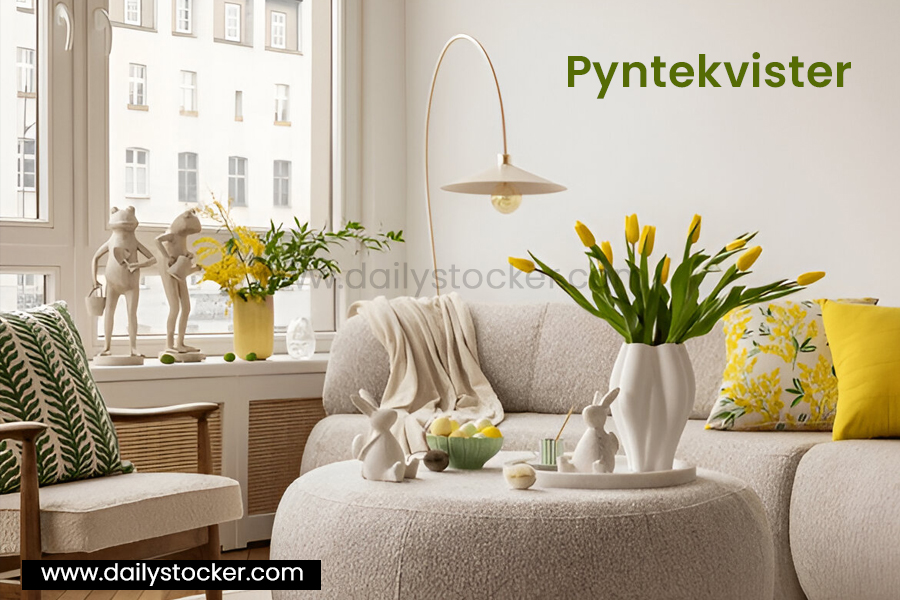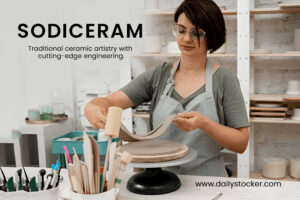Pyntekvister: The Timeless Scandinavian Decor Trend Redefining Homes in 2025
Pyntekvister are decorative twigs or branches that have become a timeless element in interior and event design. At their core, these natural accents bring the beauty of the outdoors inside, creating a warm, cozy, and stylish atmosphere. Whether used in vases, wall hangings, table centerpieces, or festive arrangements, pyntekvister add a touch of rustic elegance and creativity to any space.
In today’s design world, where minimalism meets sustainability, pyntekvister have gained popularity for their versatility. They can be left in their natural form for a raw, organic vibe or painted, glittered, and styled for a more modern and festive look. From Scandinavian homes to wedding venues, they are loved for their simplicity, charm, and endless decorative possibilities.
This article dives deep into the world of pyntekvister — what they are, their history, creative uses, styling tips, DIY projects, seasonal arrangements, and how they fit into sustainable living trends.
What Are Pyntekvister?
Pyntekvister literally translates to “decorative twigs” in Norwegian and Scandinavian languages. Traditionally, these twigs are gathered from trees, bushes, or plants during seasonal walks in nature. They can be used fresh, dried, or even treated for longevity.
In Scandinavian design philosophy, pyntekvister are more than just ornaments — they represent a connection to nature, simplicity, and harmony. They are often used in home interiors, festive celebrations like Christmas and Easter, and even in eco-friendly craft projects.
The Origins and Cultural Significance of Pyntekvister
The concept of decorating with natural branches has roots in many cultures. In Nordic traditions, pyntekvister often symbolize renewal, growth, and seasonal celebration. During spring, fresh budding branches are brought indoors as a sign of life returning after a long winter. In autumn and winter, dried branches are arranged with lights, ornaments, or ribbons to create a warm, festive atmosphere.
Culturally, pyntekvister highlight the Scandinavian design philosophy of minimalism with meaning. Instead of cluttering spaces with mass-produced items, pyntekvister remind homeowners to appreciate natural forms. This simplicity not only enhances home décor but also contributes to a more sustainable lifestyle by reducing the need for synthetic decorations.
Types of Pyntekvister
Not all branches are the same, and each type of pyntekvister brings a unique personality to home décor. Here are some of the most popular options:
1. Birch Twigs
Light in color with fine details, birch twigs are widely used in Scandinavian interiors. They symbolize purity and simplicity, making them perfect for modern minimalistic homes.
2. Willow Branches
Flexible and graceful, willow twigs are often bent into creative shapes. They are especially popular in spring and Easter decorations.
3. Cherry Blossom Branches
These twigs bring seasonal elegance, bursting with pink or white blossoms in spring. They add both freshness and charm to any living space.
4. Dried Decorative Twigs
For long-lasting arrangements, dried twigs are ideal. They require no upkeep and can be painted, glittered, or wrapped in lights for a contemporary touch.
5. Seasonal Branches
Some prefer collecting seasonal branches, such as autumn leaves or snow-frosted pine twigs, to create timely decorations throughout the year.
Seasonal Uses of Pyntekvister
One of the most exciting things about pyntekvister is how versatile they are across the seasons. Each time of year brings its own atmosphere, and branches or twigs can be styled to reflect the natural beauty of the moment. Whether it’s a cozy winter arrangement or a fresh spring decoration, pyntekvister adapt effortlessly.
Winter Magic with Pyntekvister
In winter, nature seems to go to sleep, but that doesn’t mean homes have to feel dull. Pyntekvister can bring a sense of life and festivity to indoor spaces. Many people spray-paint bare twigs with white, silver, or gold for a frosty effect. Others wrap them with fairy lights, making them glow warmly during dark winter evenings.
A popular tradition is to decorate pyntekvister with ornaments around Christmas. Instead of a large Christmas tree, some households create minimalist twig arrangements that still capture the holiday spirit. Birch and willow branches are especially charming in this context.
Spring Refresh
Spring is all about renewal, and pyntekvister perfectly symbolize new beginnings. Branches with small buds or blossoms, such as cherry, willow, or apple twigs, bring freshness indoors. Adding a few cut flowers to the arrangement enhances the seasonal feel.
In Scandinavian homes, spring decorations often include pyntekvister paired with pastel ribbons, small ceramic figurines, or Easter eggs. These arrangements create a joyful yet simple ambiance that mirrors the rebirth of nature outside.
Summer Elegance
During summer, pyntekvister can take on a more rustic or bohemian look. Driftwood, sun-dried twigs, and lush green branches become popular choices. They can be placed in vases for a light, airy feeling or used to decorate outdoor spaces like patios, garden parties, or weddings.
Summer arrangements often lean toward a natural and carefree style. People sometimes combine twigs with wildflowers, shells, or fresh herbs to make them smell delightful while also serving as decoration.
Autumn Warmth
Autumn is perhaps the most atmospheric time to use pyntekvister. Twigs paired with dried leaves, berries, and pinecones create cozy displays that highlight the rich, warm colors of the season. Arrangements with orange ribbons or small pumpkins can serve as perfect table centerpieces.
Some households use painted or naturally dark branches as a spooky Halloween decoration, combining them with candles or lanterns for an enchanting, moody effect.
How to Style Pyntekvister at Home?
Styling pyntekvister doesn’t require professional design skills. In fact, part of their charm lies in their simplicity. Here are some ways homeowners can use them:
Vase Arrangements
Placing pyntekvister in a tall glass or ceramic vase is one of the easiest ways to decorate. For a minimal look, a few bare twigs are enough. For a festive vibe, twigs can be paired with flowers, ribbons, or fairy lights.
Wall and Hanging Décor
People can mount branches horizontally on walls to hang ornaments, photos, or lights. They can also use them as natural curtain rods in bohemian-style interiors.
Table Centerpieces
A cluster of decorated pyntekvister in the middle of a dining table creates a cozy, rustic centerpiece—perfect for holiday dinners or family gatherings.
Outdoor Decorations
Pyntekvister also look wonderful outside. Garden entrances, balconies, or porches can be styled with large twigs arranged in pots, giving the home a welcoming, seasonal look.
DIY Projects with Pyntekvister
For craft lovers, pyntekvister are a dream material. They are inexpensive, versatile, and surprisingly easy to work with. Here are a few DIY projects where they shine:
DIY Candle Holders
Bundle a few slim pyntekvister around a glass jar or candle holder using twine. This instantly gives the piece a rustic, handmade look that suits cozy living rooms and Scandinavian-inspired interiors.
Decorative Wreaths
People create a traditional yet timeless project by making wreaths from pyntekvister. They shape the branches into circles, stars, or hearts and adorn them with ribbons, pinecones, or dried flowers. They’re perfect for Christmas but also adaptable for weddings and other occasions.
Hanging Mobiles
Another creative use is turning pyntekvister into mobiles. By tying lightweight ornaments, feathers, or crystals to the branches, you can create a whimsical decoration for children’s rooms or outdoor spaces.
Pyntekvister in Modern Interior Design
While pyntekvister have strong traditional roots, they have found a new place in modern interior design. Scandinavian and minimalist homes frequently use branches to create clean, natural aesthetics. Designers appreciate how they add texture and character without overwhelming a space.
Minimalist Approach
A single tall branch in a sleek ceramic vase makes a bold yet simple statement. This minimalist use of pyntekvister aligns perfectly with modern interior trends.
Rustic Elegance
For rustic-inspired homes, pyntekvister bring warmth and authenticity. They can be paired with wooden furniture, soft textiles, and muted colors to create an inviting atmosphere.
Eco-Friendly Design
Eco-conscious decorators favor pyntekvister because people often gather them sustainably. Using natural elements reduces the need for plastic decorations and highlights the beauty of renewable resources.
Care & Maintenance Tips for Pyntekvister
Proper care keeps decorative branches beautiful for a long time. Although people often use pyntekvister in their natural form, a little maintenance keeps them fresh, dust-free, and visually appealing.
Cleaning and Dusting
Over time, branches used indoors tend to collect dust. A simple way to keep pyntekvister looking new is to gently wipe them with a dry cloth or use a feather duster. For more delicate twigs, a soft paintbrush can help remove dust without breaking the finer details.
Preserving Fresh Twigs
If you prefer working with freshly cut branches, it’s a good idea to trim the stems and place them in a vase with water, just like flowers. This prevents them from drying out too quickly and keeps their natural look intact. For those who enjoy the rustic, dried appearance, simply allow the pyntekvister to air-dry in a cool, shaded space.
Protecting Against Moisture and Sunlight
Direct sunlight can cause natural twigs to fade, while too much humidity can lead to mold. Positioning pyntekvister away from damp areas ensures they maintain their shape and color. A light spray of matte sealant can also help preserve the natural tones of dried branches.
Pyntekvister in 2025: The New Favorite for Stylish Interiors
In 2025, pyntekvister—those beautifully styled decorative twigs—are more than just charming home accents. They’re riding a wave of modern design trends that favor natural, personalized, and wellness-focused spaces.
1. Biophilic Design Is Dominating
Biophilic design, which blends nature into interiors, is a major force in 2025. This movement underscores a growing desire for homes that support mental health, calm, and a connection with nature.
The organic texture and simple elegance of pyntekvister align perfectly with biophilic principles—bringing greenery, natural lines, and grounding energy into urban living environments.
2. Earthborn Elegance: A Shift Toward Organic Materials
One of the top decor trends this year is “Earthborn Elegance”—a style that emphasizes raw, organic materials like stone, wood, and clay.
Pyntekvister tap into this shift by offering tactile texture and visual warmth. Whether displayed naturally or slightly refined, they bring durable, nature-inspired aesthetics into any designscape.
3. Japandi Style Embraces Simplicity and Nature
Japandi style—a blend of Japanese minimalism and Scandinavian comfort—is gaining ground in decor circles.
Pyntekvister perfectly complement this aesthetic with their clean lines, understated elegance, and harmonious presence. They elevate minimalist interiors without overpowering them.
4. Cottage Flow: The Calm, Nature-Inspired Decor Movement
As an alternative to bold modernism, the “Cottage Flow” trend has captured attention for its relaxed, nature-centric aesthetic.
With soft textures, rustic materials, and muted palettes, this trend seeks serenity—making pyntekvister a fitting piece that adds organic beauty and understated charm.
5. Sustainable, Personalized Decor Is In Demand
Homeowners today lean toward décor that feels unique, lasting, and eco-conscious.
Pyntekvister offer just that: each arrangement is inherently one-of-a-kind, often sourced responsibly from nature, and beautifully repurposable—making them a form of sustainable, tactile expression.
Why Pyntekvister Hit the Trend Sweet Spot in 2025
| Trend Driver | Why It Matters for Pyntekvister |
|---|---|
| Biophilic Design | Mirrors the core idea of connecting built spaces with nature. |
| Earthborn Elegance | Aligns with raw, organic aesthetics and natural materials. |
| Japandi Minimalism | Supports uncluttered, serene styling—true to their form. |
| Cottage Flow Movement | Adds quiet, rustic warmth to calm, nature-inspired interiors. |
| Sustainability & Individuality | Eco-friendly, customizable, and deeply personal. |
Wrapping Up
Pyntekvister are more than decorative twigs—they are a symbol of balance, creativity, and a deeper connection to nature. From their cultural roots in Scandinavian traditions to their growing role in modern interiors, they prove that beauty often lies in simplicity.
In 2025, as design trends lean toward biophilic principles, sustainable choices, and calming aesthetics, pyntekvister stand out as versatile, eco-friendly, and endlessly customizable elements. Whether you style them in a minimalist Japandi home, a rustic cottage setting, or a festive event space, they add warmth and character wherever you place them.
For homeowners, decorators, and DIY enthusiasts alike, pyntekvister offer a chance to embrace mindful living, reduce reliance on mass-produced décor, and bring the outdoors in. Their enduring charm ensures that this timeless trend will continue to inspire creativity and elegance for years to come.
Be the first to know! Stay tuned for fresh updates and timely notifications visit: Daily Stocker!
Share this content:








Post Comment